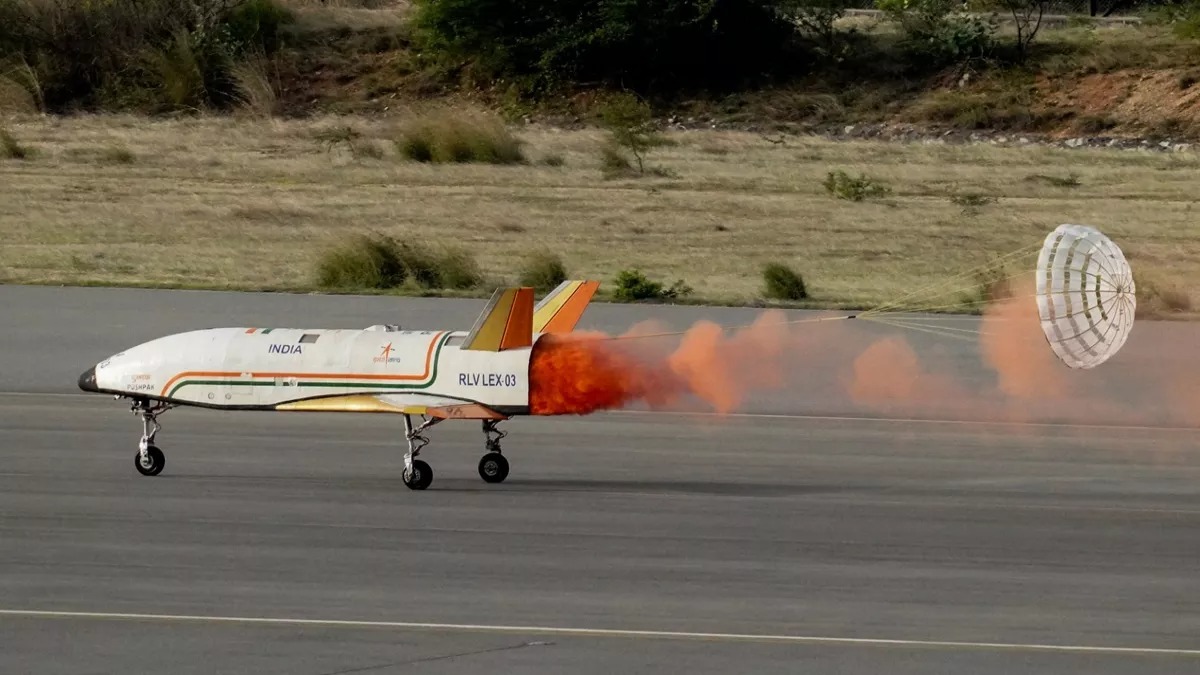
Bengaluru. India has achieved a major milestone in realizing the reusable space shuttle. The Indian Space Research Organization (ISRO) has once again done wonders and successfully landed the reusable launch vehicle (RLV) or Pushpak for the third time in a row. In this mission, the practice of landing the spacecraft returning from space was done amidst strong winds.
ISRO demonstrated the launch vehicle's automatic landing capability under more challenging conditions. ISRO Chairman S. Somanath congratulated the team for their efforts in continuing the success streak in such a complex mission. Vikram Sarabhai Space Center (VSSC) Director Dr. S. Unnikrishnan Nair emphasized that the continued success in the mission will increase ISRO's confidence in the technologies required for future orbital re-entry missions.
Landing capability demonstrated
ISRO said on Sunday that the third and final test in the series of landing experiments (LEX-03) was conducted at 07:10 am at the Aeronautical Test Range (ATR) in Chitradurga, Karnataka. In this test, ISRO tested the landing interface and landing conditions of the aircraft at high speed. Pushpak demonstrated autonomous landing capability very well.
After the success of RLV LEX-01 and LEX-02 missions, RLV LEX-03 re-demonstrated the autonomous landing capability of RLV under more challenging conditions and extremely strong wind conditions. LEX-02 was launched from a cross range of 150 m, while this time the cross range was increased to 500 m. J. Muthupandian is the Mission Director and B. Karthik is the Vehicle Director for this successful mission.
This is how the test was done
The winged vehicle 'Pushpak' (RLV-LEX-03) was carried by an Indian Air Force Chinook helicopter and released from an altitude of 4.5 km. After being released from the release point located 4.5 km from the runway, 'Pushpak' autonomously reached the runway by making 'cross-range' corrections and made a precise horizontal landing on the runway. The landing velocity of this vehicle was more than 320 kmph, whereas for a commercial aircraft it is 260 kmph and for a normal fighter aircraft it is 280 kmph.
After landing, the vehicle speed was reduced to about 100 kmph using brake parachutes. Landing gear brakes were used to reduce speed and stop on the runway. During the ground roll phase, Pushpak used nose wheel steering system to maintain balance on the runway in an autonomous manner. This mission met the standards of high speed landing conditions of RLV returning from space. It confirmed ISRO's expertise in acquiring critical technologies required for development of RLV.
The structure and flight systems of LEX-02 were used
The RLV-LEX-03 mission reused the wing structure and flight systems of the LEX-02 mission without any modifications. This demonstrates the robustness of ISRO's design capability to reuse flight systems for various missions. RLV-LEX uses multi-sensor fusion, which includes sensors such as inertial sensor, radar altimeter, flush air data system, pseudolight system and navigator.
The mission was carried out by Vikram Sarabhai Space Centre (VSSC) in collaboration with Space Applications Centre (SAC), ISRO Telemetry, Tracking and Command Network (ISTRAC), Satish Dhawan Space Centre (SDSC) SHAR. The mission received support from the Indian Air Force, Aeronautical Development Establishment, Aerial Delivery Research and Development Establishment, National Aerospace Laboratory, IIT- Kanpur, Indian Oil Corporation and Airports Authority of India.
Read More: Tied to a pole, dragged by hair... Why did the in-laws in Andhra Pradesh torture their son-in-law?
--Advertisement--

 Priya
Priya Share
Share



